One of the great things about Microsoft is that every new product complements the existing ones. That is how they have created and managed to maintain an ecosystem of their own. An excellent example of two complementary Microsoft products is SharePoint and Microsoft Teams. The two share some key features but at the end of the day, they are separate stand-alone products that when put together help organizations immensely. If you’re trying to figure out how to best integrate Teams and SharePoint, then you’re in the right place.
Before we get to the actual guide, let’s go over the two platforms, understand their differences and how using both can benefit your work.
What is SharePoint?
Released in 2001, SharePoint is Microsoft’s web-based collaborative platform that has become known as one of the best document management and storage systems.
In other words, companies can use SharePoint to build sites to store, organize, and share data. SharePoint is web-based, which means that it can be accessed through a web browser (e.g. Microsoft Edge, Chrome, or Firefox).
SharePoint is a convenient solution that allows to create a dedicated site for the entire organization, its projects, departments, or clients. Team members can use those sites to share documentation, news, resources and collaborate both with their colleagues and external users. All sites created via SharePoint can be customized and tailored to the structure and workflow of that particular team or department.
How to use SharePoint?
Building a site sounds complex but SharePoint has a user-friendly interface, so the entire process is quite simple. For starters, you need to log in to your Microsoft Office account (if you don’t have one, you have to sign up). Once logged in, on the left you’ll see a bar with all the Microsoft products, select SharePoint and you’ll see the following page. You have two options: Team site vs. Communication site.
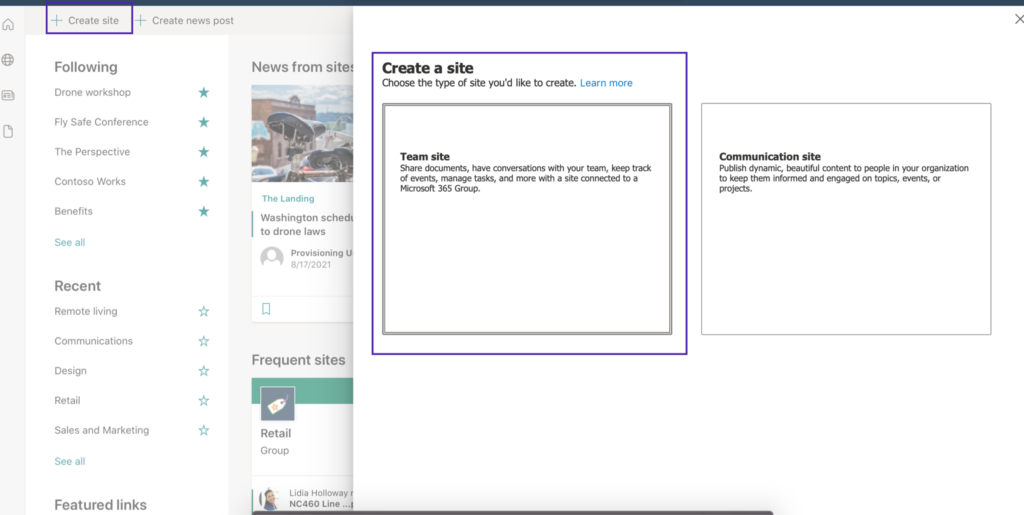
In short, a team site is designed for working jointly to create and edit content. Whereas a communication site is for sharing content for viewing and not for editing – with a smaller number of authors and larger number of viewers. You can explore the differences in more detail here.
Click on Create site on the top right corner and then from the new window, select either Team site or Communication site (in this example, we went with a Team site). Fill out the short form – name, description, privacy settings, and you’re good to go.
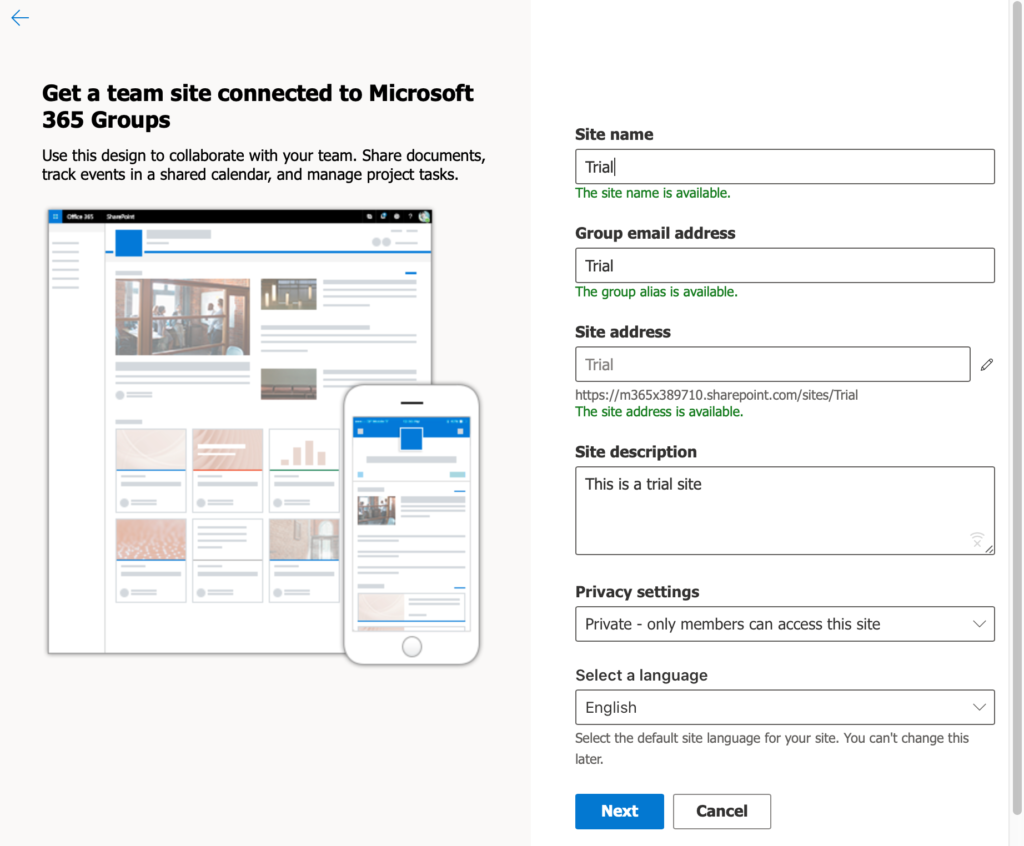
Your interface will look like the screenshot below. The main functions are listed on the left. Here is a brief overview:
- Conversations will redirect you to Outlook.
- Documents is where you can upload, share, and access various documents.
- Notebook will redirect you to OneNote, where you can take notes, share them with your team members or work on it collectively.
- Pages are your site pages. This is the dashboard where you can add new pages and edit the existing ones.
- Site contents is your table of contents or rather your site map.
- Recycle bin is self-explanatory.
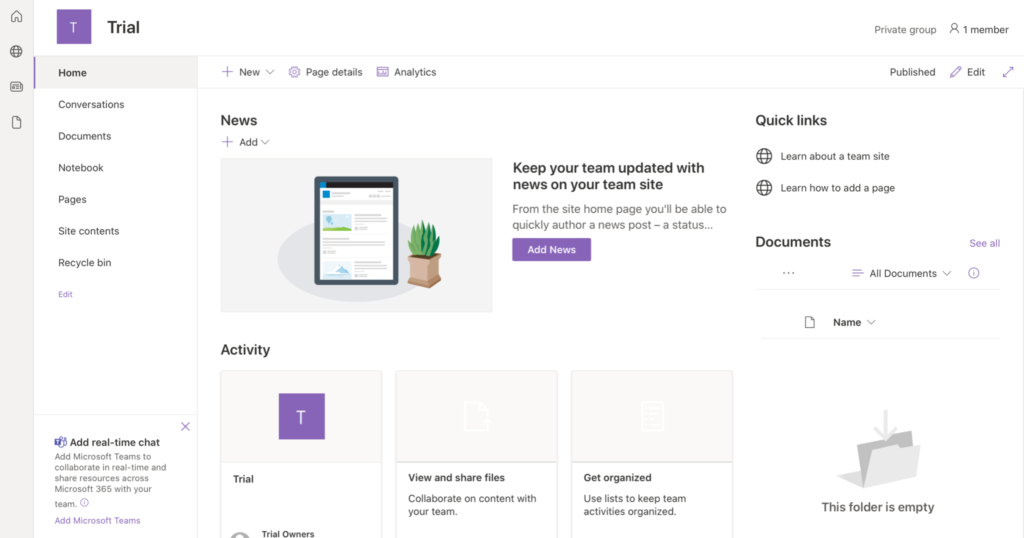
If you opt for a Communication site, here is what your dashboard will look like:
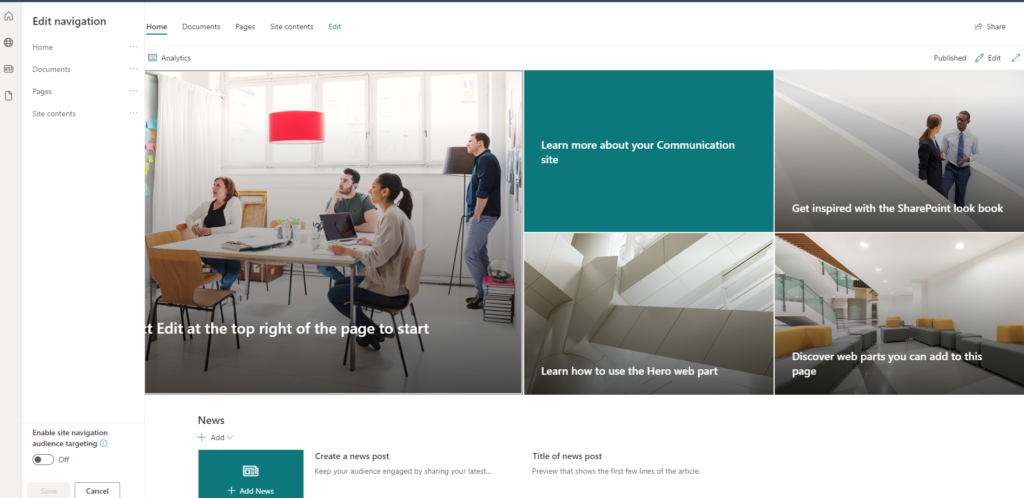
In a Communication site, you can:
- Create news posts.
- Add events.
- Share documents.
The difference between SharePoint and Microsoft Teams
Microsoft Teams is more than a video conferencing platform. It’s an all-in-one collaboration tool that allows teams to schedule and hold online meetings, chat, store and share files, collaborate on them in real time using apps like Word, PowerPoint, and Excel. Microsoft Teams also has integrations with hundreds of different apps (e.g. Trello, Salesforce, Evernote, Kahoot, etc.) that offer new functions.
Instead of sites, on Microsoft Teams you can create teams and channels based on projects, departments, or clients. The teams and their respective channels enable real-time and dynamic collaboration.
At a first glance, it seems like both SharePoint and Microsoft Teams are collaboration platforms. So, why did Microsoft duplicate itself? It didn’t.
Over time, SharePoint evolved and turned from a collaboration platform into a documentation management system (DMS). To this day, according to European SharePoint, Office 365 and Azure Conference, the following are SharePoint’s key features:
- Impressive storage capacity (1 TB per organization with additional 10 GB per license in SharePoint Online; 4 TB per content database in SharePoint On-Premises).
- Powerful indexing and metadata functionality.
- Versioning capabilities.
- Sophisticated search features.
- Multiple layers of security to protect your organization’s intellectual property.
- A wide range of supported file types, including less common ones, such as 3D models, and files with .ods and other rare extensions.
As you can probably tell, all of these – storage, search, security – are features that a great documentation management system should have. In fact, SharePoint is also the document management backbone of Microsoft Teams. Plus, it’s perfect for creating custom workflows such as tender management, recruitment, customer care, etc. SharePoint still has all the collaboration-related features, but they are simply not as user friendly as Microsoft Teams.
For starters, SharePoint is web-based, which means every single page you open becomes a separate tab. Microsoft Teams, on the other hand, has a desktop version where everything is visible all at once. Plus, it has tabs too (though they work a bit differently), so you can pin your most commonly used pages, files and apps.
Combining SharePoint and Microsoft Teams
Microsoft Teams is by default connected to SharePoint just like it is to the rest of Microsoft products like OneNote, Planner or Yammer. When you create a team in Microsoft teams, you automatically create an Office 365 group that goes with its own SharePoint site. All the files that you upload to the Files tab in Microsoft Teams are automatically stored in the SharePoint site.
So, in terms of combining and integration, it makes more sense for an organization to first create a SharePoint site and then when all documentation there is structured and organized, create respective teams.
Add SharePoint’s excellent documentation management system to Microsoft Team’s extremely user-friendly collaboration features, and you’ve got yourself an unbeatable virtual workspace.
Creating teams from SharePoint will allow you to:
- Store and access all documents for a specific Team in a single consolidated platform.
- Search and quickly locate files through a single consolidated searching system.
- Protect all your data through SharePoint’s security policies.
- Add documents to Microsoft Teams’ tabs to access them quicker.
- Add documents directly to conversations.
- Use Microsoft Teams collaboration tools (e.g. online meetings, chats, approvals, etc.) to work on the content reflected in SharePoint.
Creating teams in Microsoft Teams from SharePoint
So far we’ve learned that:
SharePoint is a:
- Place to store and manage documents.
Microsoft Teams is a:
- Tools for video conferencing and chats, and
- Productivity platform.
- Every team has its own SharePoint site
Most of the time, we simply create a new team and use the SharePoint site connected to it to store team files and other documentation. However, you can also create a new team from a SharePoint site. This solution suits organizations that deal with a lot of documentation and need a reliable and a secure place to store all those files. They can have multiple SharePoint sites for storing documentation around different scenarios.
But eventually they might also need to work on that documentation collectively through instant messaging, calls, scheduling meetings, approving the changes and more. The first part is SharePoint’s “expertise” and the second one is Microsoft Teams’ role. Examples of such organizations include legal offices, procurement departments, companies dealing with logistics, accounting and/or auditing companies, etc.
How to create teams from SharePoint
Now, onto how to actually do the integration. Go to your SharePoint account and on the bottom left corner you’ll see Add real-time chat with Microsoft Teams’ logo on it – click Add Microsoft Teams.

You will see a window on the right side of the page that outlines the benefits of Microsoft Teams. Click Continue and then Add Teams.
Once the integration is complete, you will see Teams in the menu on the left side of SharePoint. When you click on it, the platform will redirect you to the team created for that particular SharePoint site. The first time you do it, a request will be sent to the team owner to accept you.
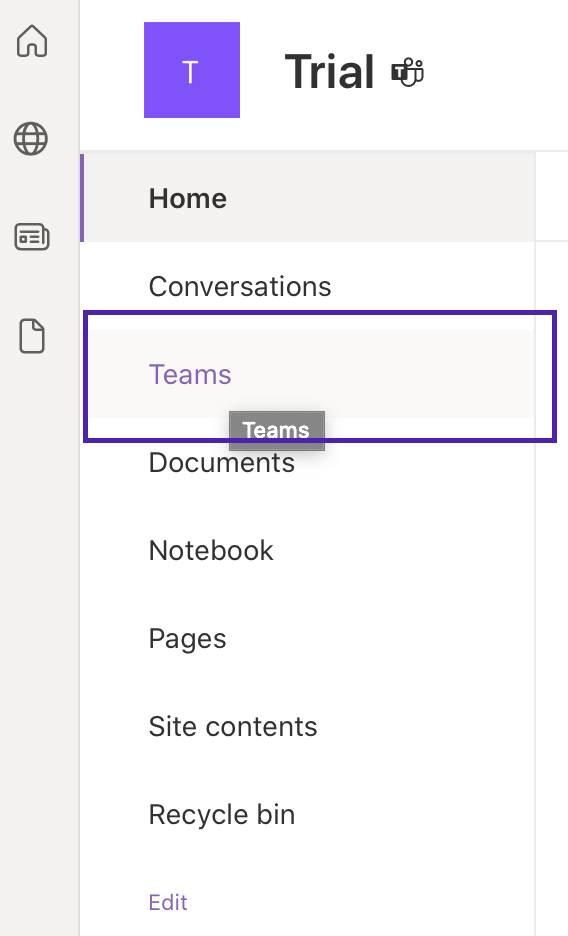
You can always use the two platforms separately or just the one, but when you combine them together, you get the best of both. The integration takes less than 5 five steps, and it doesn’t take any additional resources from you, so give it a try!
